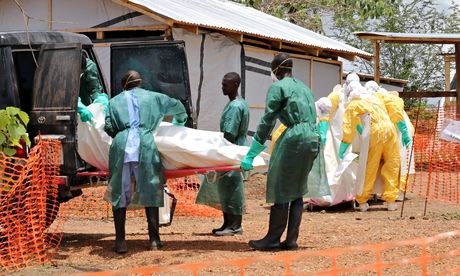Ebola Clinics Fill up as Liberia Awaits Aid
MONROVIA, Liberia — Sep 27, 2014, 9:56 AM ET
Fourteen-year-old D.J. Mulbah set off at dawn with his mother and grandmother in desperate pursuit of a coveted bed at the Ebola clinic run by Doctors Without Borders in Liberia's capital.
Too weak to stand, they bundled him up into a taxi with his backpack and a yellow plastic bucket for his vomit. Now he lay on the dirt beside the worried women awaiting word on how many new patients would enter the clinic today.
"He's been sick for a week with a runny stomach," says his distressed mother, wiping the sweat off the boy's brow with her bare hands. "We tried calling an ambulance days ago but nobody ever came."
By 8 a.m. there are a dozen suspected Ebola patients crouching and sitting on the ground outside the metal padlocked gates of the facility that can only hold 160 patients. Soon a triage nurse approaches, her voice muffled through a surgical mask covered by a plastic face shield. The news is good, and D.J. manages a faint smile: The clinic will take the boy.
His fortune though comes only from the sorrow of others: Of the 30 new beds available Saturday morning, only seven were made empty by survivors. And the limitations are stark: A sign in a staff tent inside the outdoor hospital warns: "NO IV lines to be inserted until we have enough staff."
Six months after West Africa's first Ebola outbreak emerged, generous offers of aid are finally pouring in, but beds for the sick are filling up as fast as clinics can be built. The hundreds of millions of dollars will also be arriving too late for thousands here as the world's worst-ever outbreak now has killed more than half its victims.
And even as countries try to marshal more resources to close the gap, those needs threaten to become much greater, and possibly even insurmountable. Ambulance sirens blare through standstill traffic here in Monrovia, though often there is nowhere to take the sick except to so-called "holding centers" where they await a bed at an Ebola treatment facility.
Dr. Joanne Liu, international president of Doctors Without Borders, urged world leaders this week to take "immediate action."
"The promised surge has not yet delivered," she said.
Statistics reviewed by The Associated Press and interviews with experts and those on the scene of one of the worst health disasters in modern history show how great the needs are and how little the world has done in response.
— The existing bed capacity for Ebola patients in Liberia, Sierra Leone and Guinea and Nigeria is about 820, well short of the 2,900 beds that are currently needed, according to the World Health Organization. Recently 737 beds were pledged by countries. Yet even after the promised treatment facilities are built, they will still be at least 2,100 beds short.
And if more people get sick than those who recover or die, the shortage will grow even more pronounced. MSF and other aid workers are distributing home care kits with gloves and surgical gowns to try and keep those awaiting hospital beds from infecting relatives while at home, though the distribution of thousands is still far short in Monrovia, a city of 1.6 million.
— The shortage of health workers is also great. WHO has estimated that 1,000 to 2,000 international health workers are needed in West Africa and says it is having trouble recruiting enough help. More than 200 health workers have died as they tried to save lives, complicating recruiting efforts.
Doctors Without Borders, which has more Ebola clinics than anyone, currently has 248 foreign aid workers in the region. The U.S. has pledged to train some 500 local health workers a week, but officials acknowledge that goal is unrealistic in the current environment.
The African Union has said it will deploy 100 health workers to assist the West African countries affected by Ebola. The first 30 health workers from the A.U.'s Ebola Taskforce left for Liberia on Sept 18. The next 30 are expected to leave for Sierra Leone on Oct 5, and the final 40 will be deployed to Guinea in late October.
Meanwhile, Liberia's chief medical officer placed herself in quarantine for 21 days after her office assistant died of Ebola. Bernice Dahn, a deputy health minister who has represented Liberia at regional conferences, told The Associated Press on Saturday that she did not have any Ebola symptoms but wanted to ensure she was not infected.
In Liberia's capital, construction workers are building new centers until nightfall, putting up tin-roof structures with white plastic sheeting for walls. In two weeks' time — if the work isn't delayed by the rainy season's torrential downpours — 200 sick people can be treated there.
Dr. Frank Mahoney, co-lead of the U.S. Centers for Disease Control team in Liberia, said: "We have been working furiously trying to set up treatment centers but (incoming patients) have been outpacing our ability to set them up."
Unless the situation is put under control, the outbreak may infect as many as 1.4 million people by the end of the year and nearly half of those people could die, the CDC estimated this week. More than 3,000 are currently believed to have died from Ebola, which is spread through direct contact with the bodily fluids of the sick.
"If this outbreak continues, the sheer caseload will make it much more difficult to contain," said Dr. Bruce Aylward, assistant-director general in charge of emergencies at WHO. "We will need more health workers to take care of them, more PPE (protective suits), more hospitals, more of everything."
President Barack Obama has ordered up to 3,000 U.S. military personnel to West Africa to train health workers and build more than a dozen 100-bed field hospitals including reserved sections for infected aid workers in Liberia, the country hardest hit by the disease.
Britain and France have both pledged to build field hospitals in Sierra Leone and Guinea. China is sending a 59-person lab team to Sierra Leone. Cuba will send 461 health workers, who will be trained in biosecurity, and some will go to Liberia and Guinea.
A top priority is sending enough protective equipment, including gloves, gowns, masks and boots. WHO is shipping about 240,000 protective suits a month in addition to supplies sent by other agencies. Yet there are still reports of under-sourced clinics washing and reusing protective gear that is meant to be worn once and then incinerated.
"We still do have gaps in the supply, which are quite significant," said Antonio Vigilante, the Deputy Special Representative of the U.N. Secretary-General in Liberia. "Nobody expected that the requirements of protective gear would go in the order of millions." Liberia now requires an estimated 1.3 million protective suits, Vigilante said.
One of the world's top makers of the suits, DuPont, says it has more than doubled production but would not say who has placed orders. Officials are also looking into whether protective clothing can be locally produced.
"The situation on the ground is just disastrous," said Dr. Heinz Feldmann, chief of virology at the U.S. National Institute of Allergy and Infectious Diseases, who recently returned from Liberia. "The idea of having hundreds of people in tent structures for Ebola management is unbelievable but the way this is spreading, we need to find a solution now."
http://news.newslnk.tk/6fl



 unch
unch 






